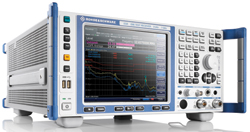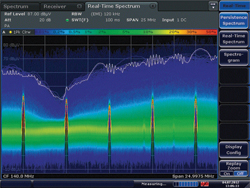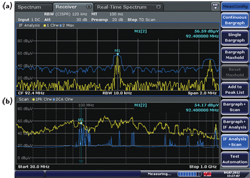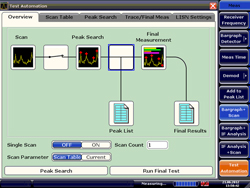
Rohde & Schwarz’s new R&S ESR EMI test receiver features comprehensive diagnostic tools such as spectrogram display, real-time spectrum analysis and IF analysis to help developers detect and eliminate electromagnetic interference. At the same time, it has all the capabilities of a full-featured, powerful signal and spectrum analyzer for lab applications and is easy to use thanks to its intuitive touch-screen interface.
The R&S ESR measures both conducted and radiated disturbances in compliance with CISPR 16-1-1 and can easily undertake EMI measurements relevant to EMC standards and product certification compliance. Like all of the company’s EMI test receivers, it is based on a powerful signal/spectrum analyzer platform (R&S FSV). With the internal pre-selection activated, it also performs standard-compliant EMI measurements in spectrum analyzer mode.
The test receiver is available in two models for frequencies ranging from 9 kHz to 3.6 or 7 GHz. An option extends the range down to 10 Hz. EMI bandwidths in decade steps from 10 Hz to 1 MHz are optionally available for measurements in line with MIL-STD-461, DO-160 and ICNIRP guidelines on exposure limits.
The R&S ESR also features time-domain scan, which is an FFT-based receiver technology that is claimed to enable it to perform measurements up to 6000 times faster than conventional EMI test receivers. In the time-domain scan mode, the instrument achieves level measurement accuracy in line with CISPR 16-1-1.
Standard-compliant measurements that took hours can now be completed in seconds. Speed is crucial when testing equipment that can be operated or measured only during a short period of time. The automotive and lighting industries are good examples because: the DUT can change its EMI characteristics during operation; extended operation might be destructive; or, the DUT may have a short operating cycle. A shorter measurement time lets users increase the dwell time per frequency segment and more reliably detect intermittent interferers with low repetition rate or isolated pulses.
The R&S ESR can measure a disturbance signal in both modes, the time domain scan mode and the conventional stepped frequency scan mode. Users decide which method is best for their application, or they can compare the results of both methods in one diagram.
Disturbance Measurement
With its real-time analysis function, the R&S ESR opens up totally new diagnostic capabilities for measuring disturbances caused by sporadic events in the frequency domain or for determining the spectral behavior of devices under test during switching operations. The spectrogram function displays the analyzed spectrum over time and records measurements for up to five hours to detect sporadic interferers. The frequency mask trigger is another useful feature. If the mask is violated, a trigger is activated, the measurement is stopped, and the user can analyze the exact cause and effect of the interferer.

Figure 1 Display showing disturbance spectrum in a split screen — persistence mode at the top and as a real-time spectrogram below.

Figure 2 In persistence mode, the R&S ESR can reveal narrowband disturbances that would otherwise be hidden by a high level broadband interference.
In persistence mode, the R&S ESR writes a pre-defined number of seamless spectra into a single diagram and displays a color-coded probability distribution of frequencies and amplitudes. This allows users to differentiate between continuous disturbances and pulse interferers present for very brief periods. It also makes it possible to detect narrowband interferers hidden by broadband signals and to identify specific pulsed disturbances, as shown in Figures 1 and 2.

Figure 3 IF analysis using a split screen: RF input signal centered at the EMI receive frequency (a) and a stored trace of the preview measurement (b).
For quick, accurate tuning to the signal of interest, the R&S ESR’s IF analysis function provides a spectral display of the RF input signal in a selectable range up to ± 5 MHz around the EMI receive frequency (see Figure 3). This provides a detailed overview of the spectrum occupancy around the measurement channel, allowing signals to be quickly classified as disturbance signals or wanted signals. AM or FM audio demodulation can be activated in parallel, making it even easier to identify detected signals.
The time-domain display function of the R&S ESR allows users to assess the disturbance’s timing behavior on a fixed frequency – comparable to using an oscilloscope. The level versus time on the set receive frequency can be measured from 50 µs to 100 s resolution. This feature can help determine the pulse repetition frequency (PRF) of a broadband disturbance or for click rate analysis to product standard CISPR 14-1.
The instrument is also easy to operate. Its 21 cm touch-screen has an 800 × 600 pixel resolution, measurement modes are distinctly separated, and the operating mode can be switched directly. Automated test sequences (preview measurement, data reduction and final measurement) are quickly configured on a single touch-screen (see Figure 4).
Interactivity
If required, the final measurement can be done interactively. With up to four million values per trace, the R&S ESR performs seamless frequency scans with narrow IF bandwidths across very wide frequency ranges. This high-frequency resolution means the disturbance frequency is measured with high accuracy – a major advantage over spectrum analyzers or test receivers that use fewer test points.

Figure 4 Users can configure automatic test sequences such as preview, data reduction, and final measurement very easily and execute them by the touch of a finger.
The EMI test receiver includes a set of typical transducers for test antennas and a selection of important limit lines compliant with commercial product RF emission standards. Users can also create their own limit lines and correction tables. Multiple correction factors can be combined in transducer sets.
The test receiver’s application spectrum is as versatile as its diagnostic capabilities. The R&S ESR makes it easy to perform acceptance testing (conducted or radiated) in line with EN/CISPR/FCC on modules, assemblies, household appliances, IT equipment, TVs, radios, etc. In the automotive sector, the EMI test receiver is suitable for acceptance testing in line with automobile manufacturer guidelines – including mobile applications thanks to the DC operation option.
Using the optional, rechargeable battery pack, the R&S ESR can record measurements for up to two hours on a single charge. Finally, R&S EMC32 software can remotely control the R&S ESR and integrate it into complex EMC systems for automated measurements.
Rohde & Schwarz,
Munich, Germany
+49 89 4129 12345
www.rohde-schwarz.com/product/esr
